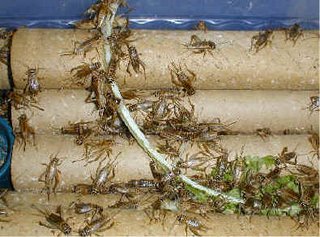Care of Crickets

Crickets have been kept in captivity for thousands of years because the singing of the adult males is considered pleasant by many people. More recently they have been kept by many people as a live food source for a great variety of carnivorous animals. However they can be kept purely for the joy of watching them as they are attractive and active little animals with a real charm of their own.
Housing
An aquarium with a tight fitting wood/mesh lid makes a good cage, the lid is to prevent the crickets from jumping, or climbing out, it needs to have ventilation holes as free flowing air is essential for the health of the cricket, a fine wire, or plastic mesh is ideal.
Though they can be kept at house temperature, in colder climes they will be more active and sing better if given some warmth, an electric light or a heat pad are useful sources of heat, a temperature of around 30 degrees is successful for most species. Most species of cricket seem happy with a regime of 16 hours of daylight to 8 hours of night including the primarily nocturnal Acheta domesticus . Furthermore most species need some sort of cover to hide in, egg cartons, the cardboard inners from toilet rolls or inverted polystyrene cups all make suitable hideaways. However making a small wood pile of dry and rotting branches 3cm to 6cm diametre by about 15cm long, or a pile of bark pieces, in one end of the tank works equally well and looks far more attractive. In the base of the tank there should be 5cm to 10cm of a peat substitute compost, this should be dampened occasionally.
Water.
Water should be made available in a shallow bowl filled with cotton wool which should be changed as it gets dirty, alternately water can be supplied in mini inverted drinkers similar to those used for poultry.
Feeding.
All crickets are omnivorous and in the wild some species are carnivorous by choice, if crickets are not kept well fed they will prey on one another. However they are easy to feed and most things can be used as food. I have found that a combination of rolled oats and bran flakes with fresh fruit and vegetables will suffice to keep them happy. Most dry dog and rabbit foods will do as well and they also like green peanuts such as you would by for a bird feeder.
Breeding.
The females will lay their eggs in the damp cotton wool, or in the soil if this is provided; the cotton wool which should be changed twice a week. The old cotton wool should be placed in a well ventilated plastic box in a warm airing cupboard and not allowed to dry out. The eggs should hatch in a week or two, depending on the temperature. The young and the adults can be kept together providing they have plenty of food. I have found that if the top of the cage is not lighted then breeding is much more difficult. I would also recommend African black crickets Gryllus spp. rather than browns Acheta domesticus for the beginner, They breed more easily, sing more lustily and they also make better food for frogs and lizards etc., as they grow bigger.
To learn more about Orthoptera (Crickets and Grasshoppers) in general visit the Earthlife WebOrthoptera Page at www.earthlife.net/insects/orthoptera.html.












<< Home